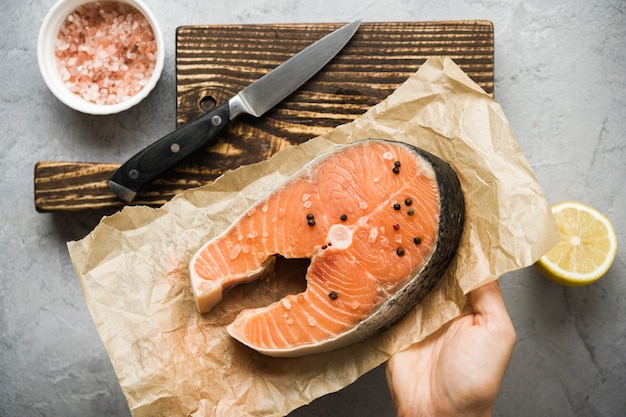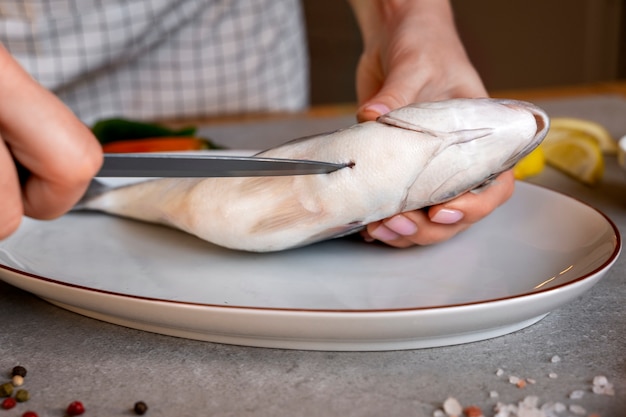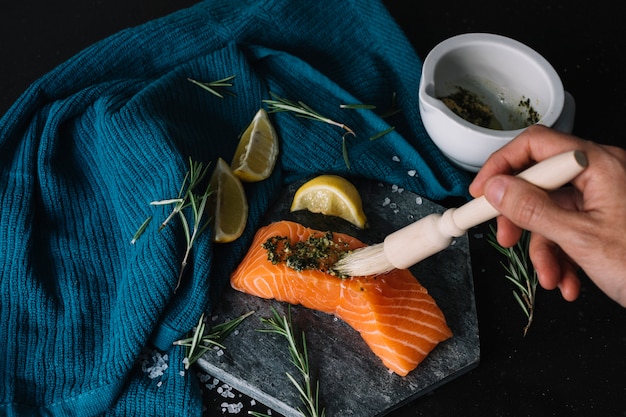There's something about a perfectly pan-seared salmon that just makes your mouth water, doesn't there? The crispy skin, the juicy flesh, the subtle, smoky flavour – it's a dish that elevates even the simplest weeknight meal. But let's be honest, achieving that perfect sear, that delicate balance between crispy and flaky, can feel like a culinary tightrope walk. I've been there, battling with overcooked salmon and soggy skin, until I finally discovered the secret to success: a few simple techniques, a touch of patience, and a whole lot of deliciousness.
I'm not talking about some fancy chef's secret – I'm just a regular home cook who loves good food and wants to share the joy of creating it. Over the years, I've tried countless recipes and techniques, and I've finally landed on the one that delivers perfectly cooked salmon, every single time. It's all about understanding the basics, and I promise, once you master them, you'll never go back to soggy, disappointing salmon again!
So, gather your ingredients, grab your favourite pan, and join me on this delicious journey to pan-searing perfection.
Part 1: choosing the right salmon

The first step to a sensational pan-seared salmon is choosing the right fish. Now, I confess, I'm a bit of a salmon snob – I crave the wild-caught varieties whenever possible. The flavour is just so much more vibrant and intense, with a depth that simply can't be replicated. But, let's be realistic, wild-caught salmon isn't always accessible or affordable. If that's the case, farmed salmon can be a great alternative. Just make sure it's sustainably sourced, which means it's been raised responsibly, with minimal impact on the environment.
salmon cuts to Choose From
Next, you'll need to choose your cut. While there are a few options, I find that for pan-searing, salmon fillets are the way to go. They offer a beautiful balance of flavour and texture, and they're the most versatile for a variety of recipes. But let's quickly break down your options:
- Salmon fillets: These are the most common cut, usually about 1-inch thick and perfect for pan-searing. They're easy to handle, cook evenly, and are perfect for a single serving or a family meal.
- Salmon steaks: These are thicker cuts, typically 1.5-2 inches thick, and require a bit more cooking time. They're ideal if you want a more substantial portion, and they hold up well to bolder flavours.
- Salmon belly: This is the fattiest part of the salmon, known for its rich flavour and melt-in-your-mouth texture. While it's delicious, it's best for grilling or baking, as it can be a bit delicate for pan-searing.
How to Choose the best salmon
Once you've decided on your cut, you want to choose a salmon that's fresh and vibrant. Here are some telltale signs to look for:
- Freshness: Look for salmon with bright, shiny skin and firm flesh. Avoid any fish that smells fishy or has a dull appearance.
- Colour: The colour of salmon can vary depending on the diet and species, but in general, you want to look for a salmon that is a deep, rich red or orange colour. Avoid any salmon that is pale or has a grayish hue.
- Fat content: The fat content of salmon is what gives it its rich flavour and juicy texture. Look for salmon with a good amount of marbling, which indicates a higher fat content.
Remember, a little bit of knowledge can go a long way when it comes to choosing the perfect salmon!
Part 2: The Crucial Pat Down

Okay, you've got your beautiful salmon fillet, and now it's time for the crucial pat down. I can't stress this enough – drying your salmon thoroughly is the first step to achieving that picture-perfect sear. Why? Because excess moisture will steam the fish instead of letting it crisp up beautifully.
So grab some paper towels and pat the salmon fillets dry on both sides. I like to press gently, removing any excess water but being careful not to break the delicate flesh. Think of it as giving your salmon a gentle massage before it takes a dip in the hot pan!
Part 3: The Art of Seasoning

Now comes the fun part – seasoning your salmon. While you can definitely get creative here, I have a few go-to combinations that I find always deliver a burst of flavour.
Basic Seasoning
For a simple, yet flavourful base, I start with salt and pepper. I use coarse sea salt, which adds a lovely crunch, and freshly ground black pepper, for a bright, peppery bite. I season generously, but not too heavily – you want the flavour of the salmon to shine through.
Herb Combinations
To add a touch of freshness, I love to incorporate herbs. My favourites are:
- Dill: Classic and delicious, dill pairs beautifully with salmon. I often use fresh dill, but dried dill works well too.
- Tarragon: This herb has a slightly licorice-like flavour that adds a subtle complexity to the dish. I like to use a mix of fresh and dried tarragon for the best flavour.
- Chives: These delicate, oniony herbs provide a refreshing touch and a subtle bite.
For a simple herb seasoning, I combine 1 tablespoon of chopped fresh dill, 1 teaspoon of chopped fresh tarragon, and 1 tablespoon of chopped chives. I sprinkle this mixture generously over the salmon.
Spice It Up
If you prefer a bit of heat, you can always add some spice to your salmon. I love using:
- Cayenne pepper: This adds a gentle warmth without being overpowering.
- Paprika: This spice gives a sweet and smoky flavour to the salmon.
- Chili flakes: If you like it hot, these will give your salmon a kick.
For a spicy rub, I mix 1 teaspoon of smoked paprika, 1/2 teaspoon of cayenne pepper, and 1/4 teaspoon of chili flakes. I rub this mixture all over the salmon.
Part 4: Preheating the Pan
Now, we're getting to the crucial part: preheating your pan. This is the secret to getting that beautiful, crispy sear. You want your pan nice and hot, so grab your trusty cast iron skillet, or any other oven-safe pan, and place it over medium-high heat.
While the pan is heating up, add a tablespoon or two of your favourite oil. I usually use olive oil for its flavour and high smoking point. Let the oil heat up until it shimmers, but be careful not to let it smoke.
Part 5: The Perfect Sear
The moment of truth has arrived! Carefully place your seasoned salmon fillets into the hot pan, skin side down. Now, here's the trick: don't touch it for at least 3-4 minutes. This is crucial for achieving that crispy, golden-brown skin.
You'll know the salmon is ready to flip when the skin releases easily from the pan and looks beautifully browned. Don't worry if it sticks a bit at first, just resist the urge to prod it. If it starts sticking too much, you can give it a gentle nudge, but be careful not to break the skin.
Flipping Time
Once the skin is nicely seared, gently flip the salmon fillets over. You only need to cook them for a few more minutes on the other side, until the flesh is just cooked through. I find that about 3-4 minutes is usually enough.
To check if the salmon is cooked through, you can use a fork to gently pierce the thickest part. If the flesh is opaque and flakes easily, it's ready.
Part 6: The Finishing Touches
Right before you take your salmon out of the pan, you can add a touch of butter for a richer flavour and a beautiful, glossy finish. Just add a knob of butter to the pan and let it melt over the salmon.
Once your salmon is cooked through, carefully transfer it to a plate and let it rest for a few minutes. This allows the juices to redistribute, resulting in a juicier, more flavorful fish.
Part 7: Serving Your Pan-Seared Salmon
Now, the fun part – deciding how to serve your perfectly cooked salmon. The possibilities are endless!
Classic Combinations
I love serving my salmon with simple, classic sides. A few of my favourites are:
- Roasted vegetables: Asparagus, broccoli, Brussels sprouts – the possibilities are endless! I like to toss the vegetables with olive oil, salt, and pepper, then roast them in the oven until they're tender and slightly caramelized.
- Green salad: A simple green salad with a light vinaigrette is the perfect complement to the rich flavour of salmon.
- Rice or quinoa: These grains are a healthy and satisfying way to round out your meal.
Getting Creative
But don't be afraid to get creative! You can also serve your salmon with:
- Pasta: Toss your salmon with your favourite pasta sauce and a sprinkle of Parmesan cheese.
- cauliflower rice: A healthy and delicious alternative to regular rice.
- sweet potatoes: Roasted or mashed, sweet potatoes add a touch of sweetness to the dish.
Part 8: FAQs
Let's address some common questions about pan-searing salmon, to make your journey to salmon perfection even smoother.
Q: What if my salmon sticks to the pan?
A: This can happen if your pan isn't hot enough or if the salmon wasn't properly patted dry. If your salmon sticks, try gently loosening it with a spatula. If it's still stubbornly stuck, you can try adding a little more oil to the pan.
Q: How can I tell if my salmon is cooked through?
A: The best way to tell if your salmon is cooked through is to use a fork to gently pierce the thickest part. If the flesh is opaque and flakes easily, it's ready. You can also use a meat thermometer, aiming for an internal temperature of 145°F (63°C).
Q: What should I do if my salmon is overcooked?
A: Unfortunately, overcooked salmon is a bit dry and tough. The best thing you can do is to try to prevent it from happening in the first place by carefully monitoring the cooking time and using a meat thermometer. However, if you do end up with overcooked salmon, you can try to salvage it by adding a sauce or topping that will add moisture and flavour.
Q: Can I pan-sear frozen salmon?
A: It's best to use fresh salmon for pan-searing, but if you're using frozen salmon, make sure to thaw it completely in the refrigerator overnight. Once thawed, pat the salmon dry with paper towels and proceed with the recipe.
Q: What can I do with leftover pan-seared salmon?
A: Leftover pan-seared salmon is perfect for salads, sandwiches, or even pasta dishes. It's also delicious cold, so you can enjoy it on a bed of greens or with a creamy dressing.
Part 9: Tips and Tricks
Here are a few more tips and tricks to make your pan-seared salmon even better:
Keep It Moist
To prevent your salmon from drying out, try adding a little bit of liquid to the pan. A splash of white wine, broth, or even a few tablespoons of water will help create steam and keep the fish moist.
A Touch of Citrus
Add a squeeze of lemon or lime juice to your pan-seared salmon for a bright, tangy flavour. You can also use a little zest for a more intense citrus flavour.
Get Creative with Seasonings
Don't be afraid to experiment with different seasonings. Try a blend of herbs and spices, or even a sprinkle of sugar for a touch of sweetness. I find that a sprinkle of smoked paprika and a pinch of brown sugar adds a delicious depth to my salmon.
Don't Overcrowd the Pan
If you're cooking multiple salmon fillets, don't overcrowd the pan. This will prevent the salmon from cooking evenly and will also lower the temperature of the pan, resulting in a less crispy sear.
Rest It
Always let your salmon rest for a few minutes after cooking. This allows the juices to redistribute, resulting in a juicier, more flavorful fish.
Part 10: Conclusion
Pan-searing salmon might seem daunting at first, but with a few simple steps and a little practice, you can become a master chef in your own kitchen. Remember the key ingredients to success: choose fresh, high-quality salmon, pat it dry, season it generously, preheat your pan, and cook it to perfection. And don't forget to experiment with different seasonings and toppings to create your own signature dish.
So go forth, my fellow food enthusiasts, and unleash your inner chef! With a little bit of effort and a lot of passion, you can create pan-seared salmon that's not only delicious but also a true work of art. Happy cooking!
Everyone is watching

How to Cook Frozen Lobster Tails Perfectly: A Step-by-Step Guide
RecipesLobster. Just the word conjures up images of lavish meals, special occasions, and a taste of luxury. But let's...

Pigs in a Blanket Cooking Time: How Long to Bake for Perfect Results
RecipesAh, pigs in a blanket. Just the name conjures up images of those delightful little parcels of crispy pastry en...

Pork Fillet Cooking Time: How Long to Cook It Perfectly
RecipesPork fillet, or tenderloin as it's sometimes called, is a real favourite in our house. It's so versatile, and...

The Ultimate Guide to Cooking Delicious Frankfurters
RecipesLet's face it, we all love a good frankfurter. It's a classic, simple, and always satisfying. But let's be rea...

Wolf Meat Recipes: A Guide to Cooking Wild Game
RecipesLet's be honest, you don't see wolf meat at your local butcher shop every day. It's a bit of a wild card, but ...
